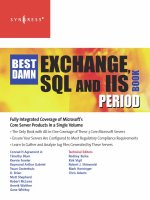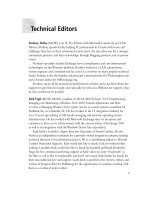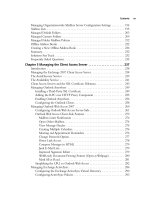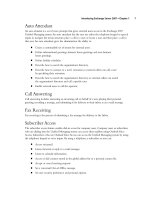Exxhange SQL And IIS- P36 pps
Bạn đang xem bản rút gọn của tài liệu. Xem và tải ngay bản đầy đủ của tài liệu tại đây (191.85 KB, 5 trang )
Managing Recipients in Exchange 2007 • Chapter 3 147
Now that looks much better.
You can also create isolated Management Consoles for the Organization Confi guration, Server
Confi guration, and Toolbox work center nodes. You can do this by following the same steps but
opening a new console window by right-clicking the respective work center node. If you have both
the Exchange 2007 Tools and the Windows AdminPak installed on a server or workstation, you can
even create a single console with access to both the ADUC snap-in and the Exchange 2007
Management Console, as shown in Figure 3.63.
Figure 3.63 A Custom User Management Console
Recipient Filtering in Exchange 2007
If you have already deployed and/or are planning to deploy Exchange 2007 in an organization
consisting of several thousand recipients, you can quickly lose the administrative overview. This is
where recipient fi ltering comes into the picture. By creating a fi lter using either the EMC or the
EMS, you will be able to fi nd the recipient or set of recipients you’re looking for in a matter of
seconds.
Creating a recipient fi lter is done by selecting the Recipient Confi guration work center node or
the particular recipient subnode. Let’s, for example, select the Mailbox subnode. Here we will create
a fi lter by clicking the Create Filter button located in the top-left corner of the Result pane, as
shown in Figure 3.64.
148 Chapter 3 • Managing Recipients in Exchange 2007
Figure 3.64 The Create Filter Button in the Exchange Management Console
After we have clicked Create Filter, we need to specify the type of property we want to fi lter
on, selecting from among 35 available property types such as Alias, Company, Custom Attributes,
E-mail Addresses, Recipient Type Details, Server, and Unifi ed Messaging Mailbox Policy. Let’s try to
create a fi lter based on the Recipient Type Details property, setting it to the Equals comparison
operator and fi nally choosing a value it should fi lter on. In this example we’ll choose Legacy
Mailbox and click Apply Filter. We could have also selected User Mailbox, Linked Mailbox,
Shared Mailbox, Room Mailbox, or Equipment Mailbox, depending on our preference.
NOTE
A total of six different comparison operators are available: Contains, Does Not
Contain, Does Not Equal, Ends With, Equals, and Starts With.
As you can see in Figure 3.65, any legacy mailboxes (mailboxes on an Exchange 2000 or 2003
server) are listed in the Result pane.
Figure 3.65 Displaying Legacy Mailbox Filtered View
Managing Recipients in Exchange 2007 • Chapter 3 149
Note that you can add expressions by clicking the Add Expression button. You can even
remove separate expressions by clicking the red cross icon to the right of the particular fi lter. You can
also remove the complete fi lter by clicking Remove Filter.
SOME INDEPENDENT ADVICE
The work center node or subnode you select has a direct impact on the operators
that will be available in the fi lter you create. In addition, depending on the
properties and the type of comparison operators you choose, you will have a
different set of values to choose from. Some combinations even allow you to type
the value yourself instead of having to choose from a drop-down box.
If you would rather perform recipient fi ltering using the EMS, you can do so with the
Get-Mailbox –fi lter command.
150 Chapter 3 • Managing Recipients in Exchange 2007
Summary
In this chapter we focused on how recipients are managed in Exchange 2007. First we had a look at
how the different recipient type objects are managed using the Exchange Management Console (EMC),
then we went through how we should deal with recipients in a coexistence environment.
We also examined, step by step, how to create a custom MMC that contains the Exchange 2007
Recipients work center, which can be used, for example, by the helpdesk staff in your organization.
Finally, we took a look at the options available when we use the new recipient fi ltering features in
Exchange 2007.
Solutions Fast Track
Managing Recipients Using the Exchange 2007
Management Console
˛ Management of recipients in Exchange Server 2007, as well as their Exchange-related
properties, has been moved back into the Exchange Management Console (EMC) in
addition to the Exchange Management Shell (EMS), both of which are based on Windows
PowerShell. This means that all management of Exchange recipient objects should be
modifi ed from within the EMC or EMS, not using the ADUC snap-in.
˛ We have four recipient type subnodes beneath the Recipient Confi guration work center.
In order, we have a Mailbox, a Distribution Group, a Mail Contact, and a Disconnected
Mailbox node.
˛ Each type of recipient object has its own individual icon as well as recipient type
description due to the fact that they now are explicit and not implicit, as was the case in
Exchange Server 2003. This is a nice addition because it makes it so much easier to
differentiate the recipient types in Exchange 2007.
˛ Although legacy mailboxes are exposed via the EMC, not all Exchange 2007-specifi c
features apply to these types of mailboxes.
˛ Because Exchange 2007 uses explicit mailbox recipient types, it’s possible to create a search
fi lter that lists all room mailboxes, for example, or perhaps all legacy mailboxes, for that
matter. Listing all resource mailboxes in the ADUC snap-in back in Exchange 2000 or
2003 using a search fi lter was not a trivial process; it required you to use custom attributes
because there was no other way to differentiate resource mailboxes from ordinary
mailbox-enabled user accounts.
˛ The Exchange 2007 Move Mailbox Wizard is the tool you should use to move legacy
mailboxes from Exchange 2000 or 2003 Server to an Exchange 2007 Mailbox Server.
˛ As is the case with Exchange 2000 and 2003, there are two types of Distribution Groups in
Exchange 2007: mail-enabled distribution groups, which are used strictly for distributing
messages, and mail-enabled security groups, which are used both to assign permissions to
users as well as to distribute messages. In addition, the query-based distribution group
Managing Recipients in Exchange 2007 • Chapter 3 151
introduced in Exchange 2003 has also made its way into Exchange 2007, albeit with a new
name and a few changes.
˛ Dynamic distribution groups, which were known as query-based distribution groups in
Exchange 2003, provide the same type of functionality as ordinary distribution groups, but
instead of manually adding members to the group’s membership list, you can use a set of
fi lters and conditions that you predefi ne when creating the group to derive its membership.
˛ We manage mail contacts (mail-enabled contacts) and mail users (mail-enabled users) under
the Mailbox Contact subnode beneath the Recipient Confi guration work center node.
˛ When you either disable or remove a mailbox, that mailbox will be marked for deletion but
will not be automatically deleted. Instead, it will be kept in the respective mailbox database for
the number of days specifi ed on the mailbox database Properties page (under the Limits tab),
called “Keep deleted mailboxes for,” more commonly referred to as mailbox retention. Like
Exchange 2000 and 2003, Exchange 2007 will, by default, keep deleted mailboxes for 30 days
before they are purged (permanently deleted).
Managing Recipients in a Coexistence Environment
˛ During a transition from Exchange 2000/2003 to Exchange 2007, deploying Exchange
2007 server into your existing Exchange organization can take a long time, depending on
the size of your existing setup and organizational layout. This means that you might have to
manage mail-enabled users from both the EMC and the ADUC MMC snap-in for a
period of time.
˛ Although you have the option of managing Exchange 2007 mailbox and mail-enabled users
using the ADUC snap-in, it isn’t supported and will result in Exchange 2007 mailboxes that
might not be fully functional. In addition, you should opt to use the Exchange 2007 tools
for moving Exchange 2000/2003 user mailboxes.
˛ The infamous Recipient Update Service (RUS), which most of us know from Exchange
2000 and 2003, is no longer part of the Exchange 2007 product. RUS was responsible for
stamping e-mail addresses, in addition to address list membership along with a few other
things, but didn’t always work as expected and was very diffi cult to troubleshoot when it
acted up. With Exchange 2007, the RUS (and thereby the asynchronous behavior used to
provision objects) has been replaced by a new synchronous process, the EmailAddressPolicy
CMDlet, used to stamp the e-mail address onto objects immediately.
Granting Access and/or SendAs Permissions to a Mailbox
˛ In some situations, one or more users might need to be granted permissions to access
another user’s mailbox. This could be a more temporary access during vacations, maternity
leave, or other reasons, where one or more users need to take over the work of the user
who will be absent. It could also be a more permanent access, where a secretary needs to
access her boss’s mailbox, for example. Another reason could be that all users in a particular
department (such as a helpdesk) need a shared mailbox.









